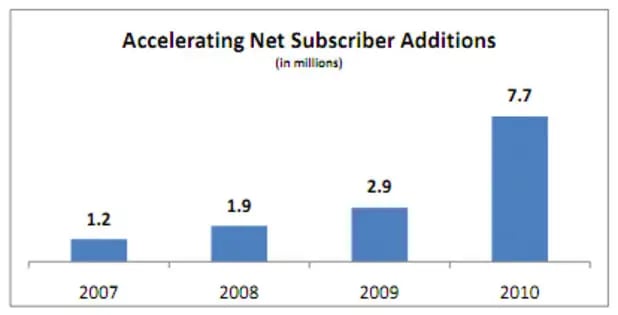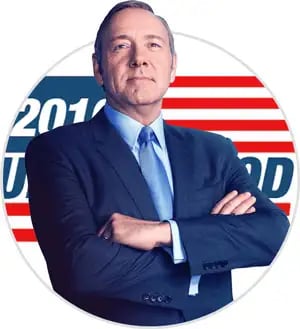Did you have fun binging on ‘House of Cards’ this weekend? Like millions of Underwood addicts, I dutifully worked my way through half of the season… and loved it.

The timing is perfect. Our country’s right in the middle of popcorn-worthy politics and, since we’ve already talked about how Netflix is putting on a clinic in how to promote content, don’t be surprised when half of your office is covering their ears and whining about spoiler alerts.
But before anyone saw the iconic series-opening scene outside of Kevin Spacey’s house, Netflix made a big bet on the unproven show to the tune of $100m for 26 episodes. That’s roughly $4m an episode or $77,000 per minute (assuming 50-minute episodes). Now everyone is hooked, everyone is watching, and the show is, by all accounts, a smashing success.
How did Netflix’s execs have the balls to take that type of risk? Shouldn’t they have gotten Ryan Seacrest to do an MVP version before fronting that much cash? The answer is a perfect case study for the power of content marketing in the age of information, and – if you’re a cord cutter or soon to be one – now’s the time to buckle up. This is the story of how ‘House of Cards’ saved Netflix and changed the content game.
Buying the rights
Maybe you knew this already but ‘House of Cards’ was originally a four episode mini-series that aired on BBC in 1990. That version is on Netflix, too, if you’re interested in Brits talking about parliament and Earl Grey tea. People liked it and over a decade later, an insistent intern at the small independent studio, Media Rights Capital (MRC), wouldn’t stop talking about the show. The studio decided to look into the rights and eventually bought them from the author around 2008.
MRC then ran it by producer David Fincher (think ‘Gone Girl’, ‘Fight Club’, ‘The Social Network’) who immediately got on board with the project. With Fincher attached and Spacey in their sights as the lead, MRC shopped the series around to different networks including the likes of HBO, Showtime, and AMC. Ultimately Netflix won the bidding and the show was announced in March 2011.
According to Ted Sarandos, Netflix’s Chief Content Officer aka Tastemaker General, when comparing the series to their internal data of streaming habits, “it looked incredibly promising, kind of like the perfect storm of material and talent.”
Before we get too ahead of ourselves, we need to take a look at where Netflix was around this time. Since going public in May 2002, the company grew slowly and steadily until late 2010 when things started to pick up. In the minds of the decision-makers, more subscribers meant “more money to license content with, which drives more subscriber growth.” That’s what the letter to shareholders said.

Source: ReadWrite
Everything seemed peachy until September 2011, when Netflix CEO and Co-Founder Reed Hastings announced that they planned to split off the DVD-rental section of the company and call it Qwikster. Remember that? Everyone freakin’ hated that idea and even though the plan was cancelled less than a month later, the damage was already done. Netflix bet on the wrong horse and investors weren’t happy.

Then came Frank Underwood…
‘House of Cards’ premiered on February 1, 2013. The week before, Netflix stocked jumped in anticipation from $14.17 to $24.22, a gain of about 70%.
Over three million new subscribers were added worldwide in Q1 2013 and the show broke even in less than six months (according to The Wire). Since then, the company’s market cap has grown over 419% with shares trading at over $100 as of March 7, 2016.

Sure, the company’s recent growth can’t all be attributed to Washington D.C.’s dramatic underbelly. But it did show Netflix the incredible value of creating new, original content rather than simply licensing old reruns. People wanted their fix. That was undoubtedly the biggest takeaway, that a hit show can lead to a dramatic increase of subscribers.
As of now Netflix has produced over 100 original programs, including documentaries, comedy specials, kids’ animations, and “tv” series.
A shift in strategy
Reed Hastings famously says that Netflix’s goal is to be the new HBO before HBO can become Netflix. HBO went through a similar rise in popularity when the network tapped into our inner mobsters and sexually liberated feminine side with ‘The Sopranos’ and ‘Sex and the City’ (in that order). Until then, most people’s interaction with the Home Box Office was trying to find unscrambled “programming” at Embassy Suites.
HBO showed that addicting, original content for a network can boost ratings. Not a huge surprise there. But when Netflix did it with ‘House of Cards’, the total number of paid subscribers dramatically increased. Something clicked and, for a technology company, that’s the type of realization where you start seeing dollar signs.
Original content was the key to growth and Netflix had to figure out how to scale the content faster than HBO could figure out how to copy their subscription model (which they did with the release of HBO Now in October 2014).
The golden age for cord cutters
You may have noticed this recently but Amazon, Hulu, HBO, Netflix, possibly Apple, and other content providers are now in an arms race to create addictive content. Because internet technology has eliminated the delivery limitations of set top cable boxes, anyone can get in the game and try to grow their subscriber base. This is fantastic news for cord cutters like myself.
Multi-billion dollar companies are spending as much money as they can to make high-quality content as fast as possible. So if it seems like there are already too many shows to keep up with, brace yourself. It ain’t getting any better.
Maybe it’s time to invest in that new couch you’ve been thinking about. Or maybe it’s time we all give up and go outside…
After I finish this season.

